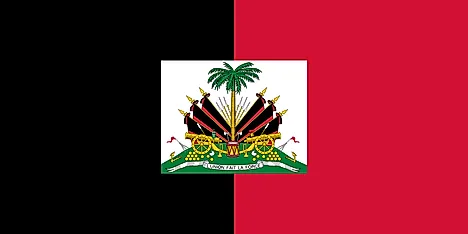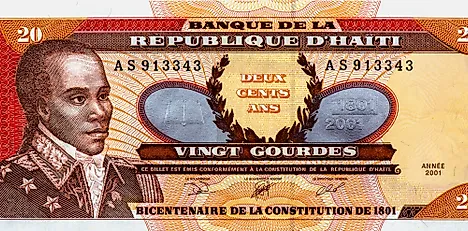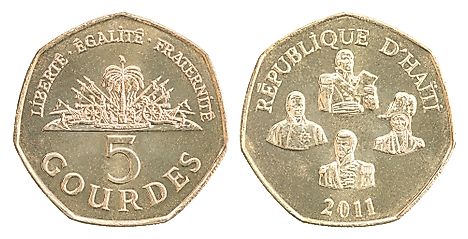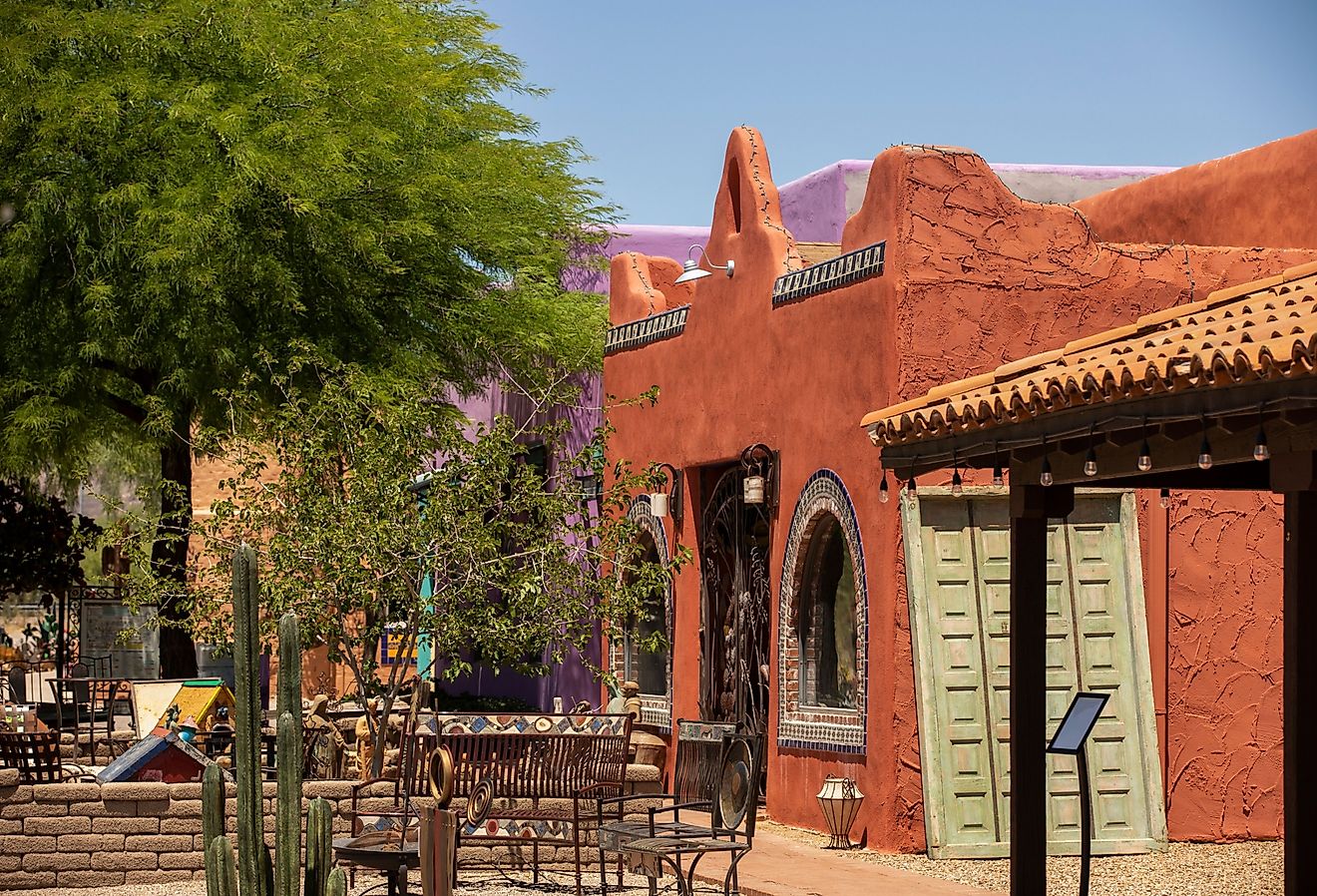Flags, Symbols, & Currencies of Haiti
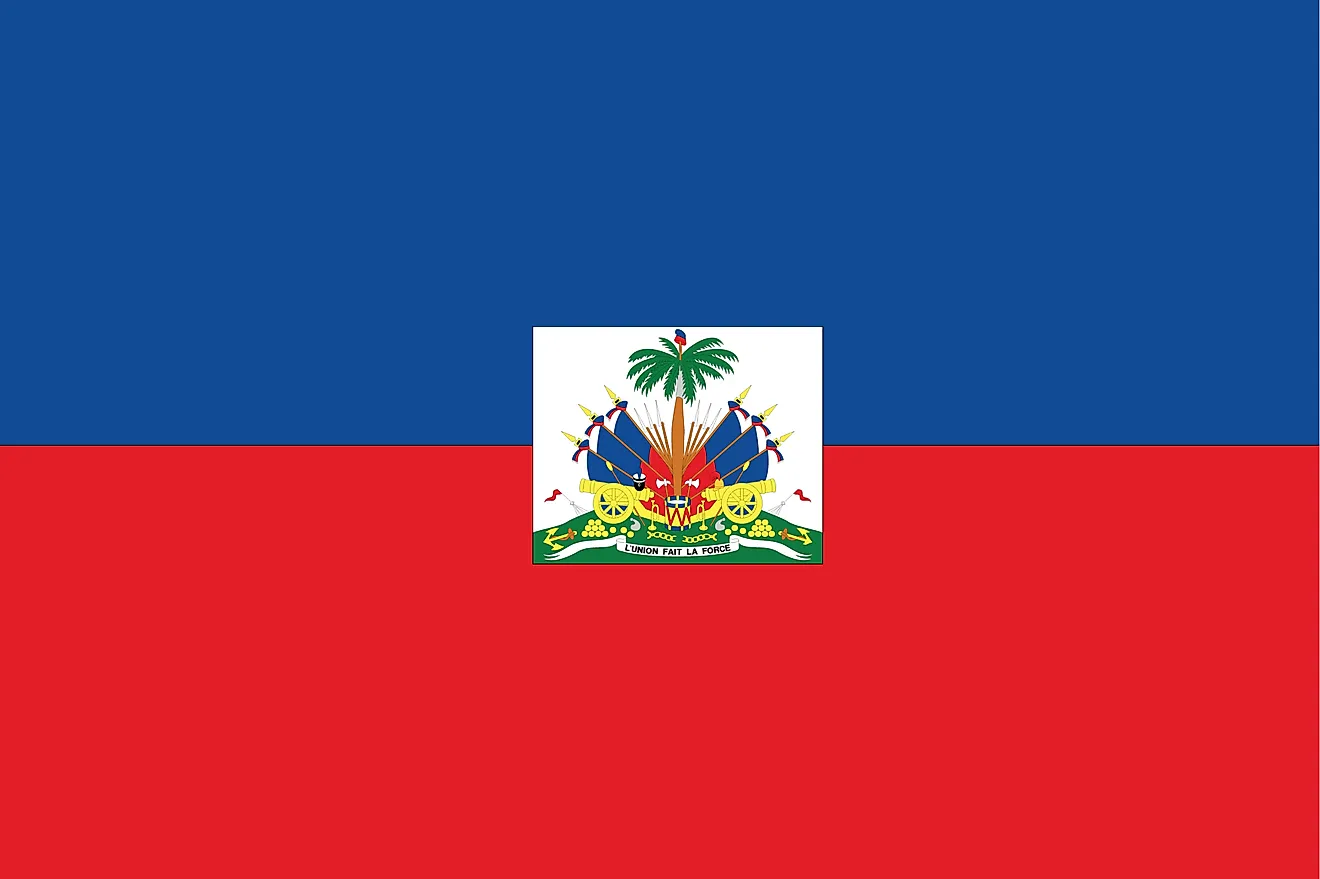
The flag of Haiti consists of two different colored horizontal bands, and a white panel bearing the national coat of arms at the center. The top band is bright blue in color, while the bottom band is red. The coat of arms of Haiti is made up of two yellowish-gold colored cannons faced in opposite directions on top of a green hill. A drum with two axes is located between the cannons and six flags are located behind the cannons (3 on each side). Running down the center of this image is a palm tree wearing a hat, known as the Liberty Cap. A white banner sits at the bottom of the hill with the Latin phrase: L'UNION FAIT LA FORCE, meaning “Strength in Unity.” As a former French colony, the blue and red colors are modeled after the French Tricolore. The flag of Haiti was officially adopted on February 26, 1986, when the country began its transition to democracy. However, the flag's design was previously used from 1859 until 1964 under the First Haitian Republic.
Symbolism of the Flag of Haiti
Residents of Haiti celebrate National Flag Day on May 18th of every year, which is a day for Haitians to celebrate the original creation of the flag. The original design is believed to have been created by Jean-Jacques Dessalines, who led the Haitian revolution. Oral histories suggests that the revolutionary figure ripped apart the French flag, removing and discarding its white center band. Dessalines gave the remaining blue and red pieces to his goddaughter, Catherine Flon, so that she could sew them together. Maintaining this story and two of the three colors of the French flag symbolizes the history of Haiti and its ability to achieve independence. Some accounts suggest that the blue and red colors are meant to represent the ethnicities living in this country. Additionally, the coat of arms is said to represent independence and freedom, which are symbolized by the palm tree at its center and the weapons on the hill.
History of the Flag
From 1625 until 1804, prior to Haiti's independence from France, its flag was white with the image of the French crown over a blue shield that held three fleur-de-lis. After the revolution, Haiti adopted a vertical bi-color of black and red that was only used for two years. This flag was followed by the flag of the State of Haiti, from 1806 until 1811, but substituted the black color for dark blue. As a kingdom, Haiti reverted back to the black and red bicolor flag, but changed the positions of the colors. From 1811 until 1814, the flag had a golden image of two lions holding a shield with a bird rising from flames. In 1814 this center image was changed to a blue disc with a crown on top. The colors of the current flag were first adopted in 1848, although its center image included two lions holding a shield with a bird, as well as the royal palm tree used today.
Symbols of Haiti
National Coat of Arms of Haiti

The coat of arms of Haiti consists of six draped flags of the country, three on each side, which are located in front of a palm tree and cannons. In front of the cannons are a drum, a bugle, long guns, and ship anchors. Above the palm tree, there is a Phrygian cap placed as a symbol of freedom. Just above the ribbon with the motto are two pieces of chain with a broken link symbolizing the broken chain of slavery. On the ribbon is the national motto of Haiti "L'Union Fait La Force" which means "Union Makes Strength".
National Anthem
- Anthem Title: La Dessalinienne (The Dessalines Song)
- Music composer: Nicolas Geffrard
- Lyricist: Justin Lhérisson
- Date of Adoption: January 1, 1904
La Dessalinienne was composed by Nicolas Geffrard, with writing the lyrics. The anthem is named in honor of Jean-Jacques Dessalines, Haiti's first leaders and revolutionarist. A competition for a national anthem was helod in 1903 to commemorate Haiti Revolution's 100th anniversary. The words of Nicolas Geffrard and Justin Lhérisson were considered the best by the judges. The anthem was officially adopted on January 1, 1904.
La Dessalinienne (French)
Pour le Pays, Pour les ancêtres,
Marchons unis, Marchons unis.
Dans nos rangs point de traîtres!
Du sol soyons seuls maîtres.
Marchons unis, Marchons unis
Pour le Pays, Pour les ancêtres,
Marchons, marchons, marchons unis,
Pour le Pays, Pour les ancêtres.
Pour les Aïeux, pour la Patrie
Bêchons joyeux, bêchons joyeux
Quand le champ fructifie
L'âme se fortifie
Bêchons joyeux, bêchons joyeux
Pour les Aïeux, pour la Patrie
Bêchons, bêchons, bêchons joyeux
Pour les Aïeux, pour la Patrie.
Pour le Pays et pour nos Pères
Formons des Fils, formons des Fils
Libres, forts et prospères
Toujours nous serons frères
Formons des Fils, formons des Fils
Pour le Pays et pour nos Pères
Formons, formons, formons des Fils
Pour le Pays et pour nos Pères.
Pour les Aïeux, pour la Patrie
O Dieu des Preux, O Dieu des Preux!
Sous ta garde infinie
Prends nos droits, notre vie
O Dieu des Preux, O Dieu des Preux!
Pour les Aïeux, pour la Patrie
O Dieu, O Dieu, O Dieu des Preux
Pour les Aïeux, pour la Patrie.
Pour le Drapeau, pour la Patrie
Mourir est beau, mourir est beau!
Notre passé nous crie:
Ayez l'âme aguerrie!
Mourir est beau, mourir est beau
Pour le Drapeau, pour la Patrie
Mourir, mourir, mourir est beau
Pour le Drapeau, pour la Patrie.
The Dessalines Song
For the country,
For the ancestors,
Let us march. Let us march united.
Let there be no traitors in our ranks!
Let us be masters of our soil.
United let us march
For the country,
For the ancestors.
For the forefathers,
For the country
Let us toil joyfully.
When the field is fertile
Our soul strengthens.
Let us toil joyfully
For our forebears,
For our country.
For the country
And for the forefathers,
Let us train our sons
Free, strong, and prosperous,
We shall always be brothers.
Let us train our sons
For the country
And for the forefathers.
For the forefathers,
For the country,
Oh God of the valiant!
Take our rights and our life
Under your infinite protection,
Oh God of the valiant!
For the forefathers,
For the country.
For the flag,
For the country
To die is a glorious deed!
Our past cries out to us:
Have a seasoned soul!
To die is a glorious deed,
For the flag,
For the country.
The Currency of Haiti is the Haitian gourde
The official currency is the Haitian gourde, coded as HTG on the ISO 4712 currency code and denoted as G. All paper bills and coins are printed in the form of Haitian gourde. The Banque de la République prints and distributes the gourde in subunits of 100 centimes. In addition to the Haitian gourde, the US dollar and the Haitian dollar are also notable. The US dollar is commonly accepted as a medium of exchange in many businesses on the bays. The "Haitian dollar" does not physically exist, but is a concept of the Haitian people who believe that 1 Haitian dollar equals 5 Haitian gourde, a rate that has remained constant throughout history. This was as a result of pegging the US dollar to the gourde at a rate of 5:1.
Coins
Coins were reintroduced in 1881 in a range of denominations including 1, 2, 10, 20, and 50 centimes. The production of coins ceased in 1890, but resumed in 1949 with the issuance of the 5 and 10 centimes coins and the 20 centimes in 1958, 50 centimes in 1972, and 1 and 5 gourde in 1995. Today, only the 50 centimes, and the 1 and 5 gourde coins are in circulation.
Banknotes
The minting of banknotes began in 1875 until 2004, with the 5 and 10 centimes, and later developments of banknotes in denominations of 10, 20, 25, 50, 100, 250, 500, and 1,000 gourde, which remain in circulation. Each denomination features the image of an historic symbol with special relevance to Haitian historic happenings.
Historical Currencies of Haiti
The first Haitian gourde was introduced in Haiti in 1813 to replace the Haitian livre, which was a French colonial currency. The earliest Haitian gourde coins were introduced in 1827 and came in denominations of 50 and 100 centimes, followed by 1 and 2 centimes in 1828, and then 6¼ centimes in 1850. In 1863, the last coins of the first gourde were minted and distributed by the Mint of Birmingham. Banknotes were also printed in denominations of 1, 2, 5, 10, 20, 25, 50, 100, 500, and 1,000 gourdes.
The gourde was officially revalued at the ratio of 10:1 in 1870. During this reevaluation, only banknotes worth 10 and 25 gourdes were issued. The second reevaluation occurred two years later in 1872, when the revaluation was done at 300:1. During this reevaluation, only banknotes were issued, with the majority dated 1885. In order to give the gourde a value in the international market, it was pegged to the French franc. However, in 1912, it was changed and pegged to the US dollar.

